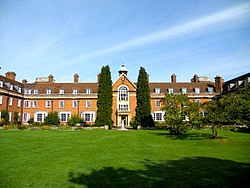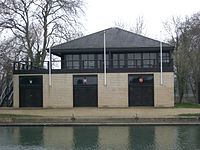Difference between revisions of "St Hugh's College, Oxford"
(Created page with "{{Infobox college |name=St Hugh's College |county=Oxfordshire |university=Oxford |city=Oxford |picture=Sthughs.jpg |os grid ref=SP50930770 |latitude=51.765675 |longitude=-1.26...") |
(No difference)
|
Latest revision as of 13:40, 19 March 2024
| St Hugh's College Latin: Collegium Sancti Hugonis
| |||||||||||||||||

| |||||||||||||||||
|---|---|---|---|---|---|---|---|---|---|---|---|---|---|---|---|---|---|
| Principal: | Lady Elish Angiolini | ||||||||||||||||
| Website: | st-hughs.ox.ac.uk | ||||||||||||||||
| |||||||||||||||||
| Location | |||||||||||||||||
| Grid reference: | SP50930770 | ||||||||||||||||
| Location: | 51°45’56"N, 1°15’48"W | ||||||||||||||||
St Hugh's College is one of the constituent colleges of the University of Oxford. It is located on a 14½ acre site on St Margaret's Road, to the north of the city centre.
The college was founded in 1886 by Elizabeth Wordsworth as a women's college, and accepted its first male students in its centenary year in 1986. It enjoys a reputation as one of the most attractive colleges because of its extensive gardens.[1]
Contents
History
Founding and early years
St Hugh's was founded in 1886 by Elizabeth Wordsworth (great-niece of the poet William Wordsworth) as a women's college, to help the growing number of women "who find the charges of the present Halls at Oxford and Cambridge (even the most moderate) beyond their means".[2] Using money left to her by her father Christopher Wordsworth, who had been Bishop of Lincoln, Wordsworth established the new college at 25 Norham Road in North Oxford.[3] She named the college after one of her father's 13th-century predecessors, Hugh of Lincoln, who was canonised in 1220, and in whose diocese Oxford had been.[4]
The college was initially accommodated in properties in Norham Road, Norham Gardens and Fyfield Road.[5] The first principal being Charlotte Anne Moberly, its first students were Jessie Annie Emmerson, Charlotte Jourdain, Constance E. Ashburner, Wilhelmina J. de Lorna Mitchell and Grace J. Parsons.[6] Students were required to ask the principal before accepting invitations to visit friends, and the college gates were locked at 9pm.[6] Records show that rent was between £18 and £21 a term, depending on the size of the room, with fires being charged extra.[7] At first tuition and lectures were arranged by the Association for the Education of Women, the first college tutor being Dora Wylie, appointed around 1898.[8]
The college began to move to its present site in 1913, when it purchased the lease of a house called "The Mount" from the Rev Robert Hartley for £2,500. This house stood on the corner of St Margaret's Road and Banbury Road, and the freehold was owned by University College.[5] The house was later demolished to make way for the Main Building of the college, which was constructed between 1914 and 1916 thanks to a gift from Clara Evelyn Mordan; the college's new library was named Mordan Hall in her honour.[9] The first book was a copy of Sale's translation of the Koran, which was given to the college by the then Bishop of Tokyo.[10] In 1919, J. R. R. Tolkien began to tutor undergraduates at St Hugh's, given that the women's colleges were in great need of good teachers in their early years, and Tolkien as a married professor (then still not common) was considered suitable, as a bachelor don would not have been.[11]
The college soon took over other properties nearby. The leasehold of 4 St Margaret's Road was acquired in 1919; it became the first "College house".[5] The leasehold of 82 Woodstock Road was donated to the college by Joan Evans in 1924, and 89 Banbury Road was purchased from Lincoln College for £7,000 in 1927.[5] The college obtained the freehold to the main site in 1927, and a year later the first stage of the Mary Gray Allen building was constructed on what had been the tennis courts.[5] The freeholds of 1–4 St Margaret's Road and 74–82 Woodstock Road were purchased from St John's College in 1931 and 1932 respectively.[5] The college received a royal charter in 1926.[12]
In 1936, 1 St Margaret's Road was demolished, and a new library was built in the Mary Gray Allen building; it was named the Moberly Library after the first principal of the college[5] (the library was extensively renovated between 1999 and 2000 and renamed the Howard Piper Library after a St Hugh's alumnus, after his parents made a large donation to the college).
Second World War
At the outbreak of the Second World War the college site was requisitioned by the military for use as the Hospital for Head Injuries under the directorship of Hugh Cairns, the first Nuffield Professor of Surgery.[13] Brick huts were constructed in the college grounds with space for 300 beds. Between 1940 and 1945, over 13,000 servicemen and women were treated at the college.[13] Advances in medicine discovered at the hospital meant the mortality rate for brain-penetrating injuries fell from 90% to 9%.[13] Staff and students were relocated to Holywell Manor, Savile House and St Hilda's College for the duration of the war.[14]
In 1943 the college acquired the leasehold of 72 Woodstock Road (known as The Shrubbery) from Dame Gertrude Whitehead for £1,500. It was used as a club for American soldiers during the war.[14] In 1946, it was leased to the University of Paris as the Maison française d'Oxford, an Anglo-French educational establishment. One of the cottages in the grounds of number 72 was later leased by Barbara Gwyer after her retirement as principal.[14]
1945 onwards
The college buildings were de-requisitioned in 1945. The hospital huts were initially leased as offices to university departments, including the Bureau of Animal Population, the Department of Zoological Field Studies and the Institute of Statistics, before being demolished in 1952.[14] Agnes Headlam-Morley, a fellow of St Hugh's, became the first woman to hold a chair at the University of Oxford in 1948.[15]
In 1951 the college purchased the freeholds to 85 and 87 Banbury Road and 9 to 13 Canterbury Road from St John's College. In addition, the freehold of The Shrubbery was acquired; this meant the college now owned the freehold of the entire 14½-acre site.[14] The college extended the Main Building in 1958.[16]
The 1960s saw an extensive programme of building work at St Hugh's. The Shrubbery was converted into the principal's lodgings in 1963.[16] Between 1964 and 1965 the Kenyon Building was constructed to provide accommodation for students[16] (designed by modern architect David Roberts, the building is a Grade II listed building.[17] The Wolfson Building was built between 1966 and 1967.
The chapel was renovated in 1980; a new organ was installed.[16] The following year, 78, 80 and 82 Woodstock Road were also renovated. The houses are now named SH Ho House, Ho Tim House and KK Leung House in recognition of the gifts from the three Hong Kong benefactors that funded the renovations.[16]
Arrival of co-education
In 1964, New College made a proposal for the admission of women to the men's colleges, and by the early 1970s several Oxford colleges had become mixed to a limited degree in this way. In 1979, two women's colleges, Lady Margaret Hall and St Anne's, reciprocated by admitting men as undergraduates, while St Hugh's, which was already employing male college lecturers, decided to admit men as Fellows. Resistance to full co-education was led by those who predicted that it would have severely negative effects on women academics and who saw other advantages in women's colleges. Admitting men as undergraduates was first proposed to the governing body in 1980, and there was a majority for it, but it did not secure the required two-thirds majority. The college principal, Rachel Trickett, fought off full co-education at St Hugh's for some years, even taking her case to the national newspapers, and it was not finally agreed until 1986.[18] When Trickett retired in 1991, she was succeeded by the first male Principal, Derek Wood[19]
A new boathouse was constructed for the St Hugh's Boat Club (jointly with St Anne's and Wadham Colleges) between 1989 and 1990. This was followed by the construction of the Rachel Trickett Building between 1991 and 1992 at a cost of £3.4 million.[10]
Buildings and location
St Hugh's occupies a rectangular site in North Oxford. It is bordered by Banbury Road to the east, Woodstock Road to the west, St Margaret's Road to the north (the front entrance) and Canterbury Road to the south (the back gate). The gardens of the college cover about ten and a half acres.[20][21]
The main entrance of the college leads straight into the Main Building, containing accommodation, teaching facilities, the chapel, and the dining hall.
Outside links
| ("Wikimedia Commons" has material about St Hugh's College, Oxford) |
References
- ↑ Wintle, Justin (2008) Perfect Hostage. Random House, p. 177.
- ↑ St Hugh's College Spring Newsletter 2010; p. 2
- ↑ Judy G. Batson, Her Oxford, Vanderbilt University Press, 2008. St. Hugh's: Life on a Shoestring, pp. 51–56. ISBN 978-0-8265-1610-7.
- ↑ Penny Griffin, St Hugh’s: One Hundred Years of Women’s Education in Oxford (1986), pp. 17, 105
- ↑ 5.0 5.1 5.2 5.3 5.4 5.5 5.6 St Hugh's College Spring Newsletter 2011; p. 9
- ↑ 6.0 6.1 St Hugh's College Spring Newsletter 2011; p. 13
- ↑ St Hugh's College Spring Newsletter 2011; p. 14
- ↑ Penny Griffin, St Hugh's: One Hundred Years of Women's Education in Oxford, Palgrave Macmillan UK, 1986. Early History p. 25. ISBN 9781349077250.
- ↑ St Hugh's College Spring Newsletter 2011; p. 13
- ↑ 10.0 10.1 St Hugh's College Spring Newsletter 2011, p. 12
- ↑ Zettersten, A. (25 April 2011). J. R. R. Tolkien's Double Worlds and Creative Process: Language and Life. Springer. ISBN 978-0-230-11840-9. https://books.google.com/books?id=6Q_GAAAAQBAJ&pg=PA134.
- ↑ at page 2
- ↑ 13.0 13.1 13.2 St Hugh's College Spring Newsletter 2011 at page 20
- ↑ 14.0 14.1 14.2 14.3 14.4 St Hugh's College Spring Newsletter 2011 at page 10
- ↑ "Women at Oxford". http://www.ox.ac.uk/about/oxford-people/women-at-oxford.
- ↑ 16.0 16.1 16.2 16.3 16.4 St Hugh's College Spring Newsletter 2011 at page 11
- ↑ National Heritage List 1392941: St Hugh’s College Kenyon Building (Grade II listing)
- ↑ Laura Schwartz, A Serious Endeavour: Gender, Education and Community at St Hugh's, 1886-2011 (Profile Books, 2011), pp. 114–118
- ↑ Schwartz (2011), p. 22
- ↑ Alden's Oxford Guide'. Oxford: Alden & Co., 1958; p. 123
- ↑ "Of the women's colleges S. Hugh's has indisputably the best garden, and for many years now it has been under the loving care of Miss Rogers. It is a well-planned garden, and ... full of interest all the year round."--Rohde, Eleanour Sinclair (1932) Oxford's College Gardens. London: Herbert Jenkins; pp. 173-78
- Schwartz, Laura (2011). A Serious Endeavour: Gender, Education and Community at St Hugh's, 1886-2011. Profile Books. ISBN 978-1-84765-780-0.
| Colleges of the University of Oxford | |
|---|---|
| Colleges:
All Souls • Balliol • Brasenose • Christ Church • Corpus Christi • Exeter • Green Templeton • Harris Manchester • Hertford • Jesus • Keble • Kellogg • Lady Margaret Hall • Linacre • Lincoln • Magdalen • Mansfield • Merton • New College • Nuffield • Oriel • Pembroke • The Queen's • Reuben • St Anne's • St Antony's • St Catherine's • St Cross • St Edmund Hall • St Hilda's • St Hugh's • St John's • St Peter's • Somerville • Trinity • University • Wadham • Wolfson • Worcester |
|
| Permanent private halls:
Blackfriars • Campion Hall • Regent's Park College • St Benet's Hall • St Stephen's House • Wycliffe Hall | |



